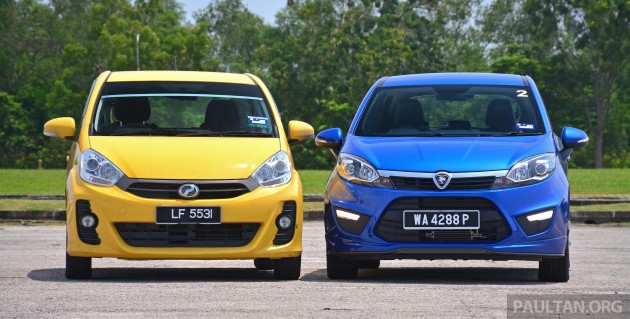A “Youth First Vehicle Scheme” was proposed by Umno youth chief Khairy Jamaluddin last week, where the idea is that young people earning under RM4,000 a month can buy their first car without paying tax on it. This will allow a young person just starting out to be able to afford a new locally-assembled car with less strain on the person’s finances.
But how much impact would a duty-free first purchase actually have on a first time car buyer? We decided to calculate how much being able to buy your first car duty free would save you every month in terms of monthly installments, based on a 10% downpayment, 3.5% interest and a seven-year loan structure.
We pay three different kinds of tax on our cars – import duty, excise duty and sales tax. All three types of taxes are exempted in duty-free zones like Langkawi, so we decided to compare Peninsular Malaysia and Langkawi prices for each car to get the effective duty-free price.
For Perodua cars, we had to compare Kota Kinabalu and Labuan prices because we could not find Langkawi prices on Perodua’s website. Both KK and Labuan prices will have East Malaysian transport costs built in, so it’s a more appropriate apple-to-apple comparison than comparing Peninsular Malaysia and Labuan prices.
We picked a few Protons, Peroduas, Honda and Toyotas for this exercise, with the cheapest and most expensive variants of each model included to establish some kind of ‘range’. Looks like you’ll be able to save between RM30 to RM330 per month, based on the choices of cars above.
The price difference between the normal price and duty-free price of Proton and Perodua models are – as expected – not that huge, with the lowest being 4.25% and the highest being 13.9%. But what’s surprising is that the gap between the normal and duty-free prices for the Hondas and Toyotas are quite different.
The City and Jazz generally have a 17% gap between the normal and duty-free prices, while the Vios has a 25% gap on average. Does this mean a Toyota buyer is paying more taxes on his car, though? Maybe Honda has more incentives because of more localisation, or maybe not. It’s hard to know why. You should treat the table above only as a guide, because we don’t know how much the transportation costs contribute towards the Langkawi prices.
A few years ago, Thailand launched a first-car scheme, under which the buyer had to be at least 21 years of age and own the car for at least five years. The car had to be completely built in Thailand and not be worth over one million baht (RM102k). Its engine had to be smaller than 1.5 litres, and the purchase had to take place between September 16, 2011 and December 31, 2012. Once these conditions were met, the buyer was eligible for tax refunds with a ceiling of 100,000 baht (RM10,200) per unit.
Thailand’s scheme didn’t quite work as intended, leaving more than 100,000 indebted customers defaulting on their loans because they couldn’t actually afford the cars in the first place, Reuters reported. The cost of purchasing a car may have become cheaper, but the benefits of travelling with your own personal roof over your head comes with higher costs such as fuel, service, insurance and tyres, just to name a few.
The first car scheme’s tax breaks cost the Thai government US$2.5 billion (RM8.37 billion), according to World Bank estimates. How much does the Malaysian government earn from car taxes every year then? The grand total is RM9.8 billion in 2013, comprising of RM480 million in import tax, RM7,308 million in excise duty, and RM2,039 million in sales tax.
Malaysian household debt levels are among the highest in the region, and giving fresh grads more of an “excuse” to buy a new car may be bad for their financial health – for example, removing RM1k a month off from their take-home pay means that they won’t be able to afford a house, which is of course the biggest complaint young people have these days.
Also, lower car prices won’t mean they’ll have more money to spare – there’s the likelihood that buyers will just max out their budget with a more expensive car. Will a First Car scheme work for Malaysia? Let us know what you think in the comments section.
Looking to sell your car? Sell it with Carro.















AI-generated Summary ✨
Comments mainly focus on car prices, taxes, and affordability for young Malaysians, debating the effectiveness of Khairy's "Youth First Vehicle Scheme." Many express doubts about the scheme's ability to truly benefit first-time buyers, highlighting high taxes, import duties, and the expensive nature of cars like Vios and Axia. Several argue public transportation should be improved instead of focusing on cheaper cars, citing overcrowded and unreliable systems. Others criticize local car protectionism and advocate for liberalization, open markets, and better infrastructure. There's also a recurring sentiment that the scheme may be a political ploy to garner votes, with some warning it could lead to increased debts and bankruptcies among youth. Overall, many believe the scheme's benefits are limited or skewed, emphasizing the need for systemic solutions like improved public transit and financial education.